Potatoes, scientifically called Solanum tuberosum, are a versatile and beloved crop that belongs to the nightshade family (Solanaceae). They are primarily cultivated for their nutrient-rich and starchy tubers that serve as a staple food in many cuisines worldwide. Potato farming has become an essential agricultural practice globally due to the high demand for this versatile crop.
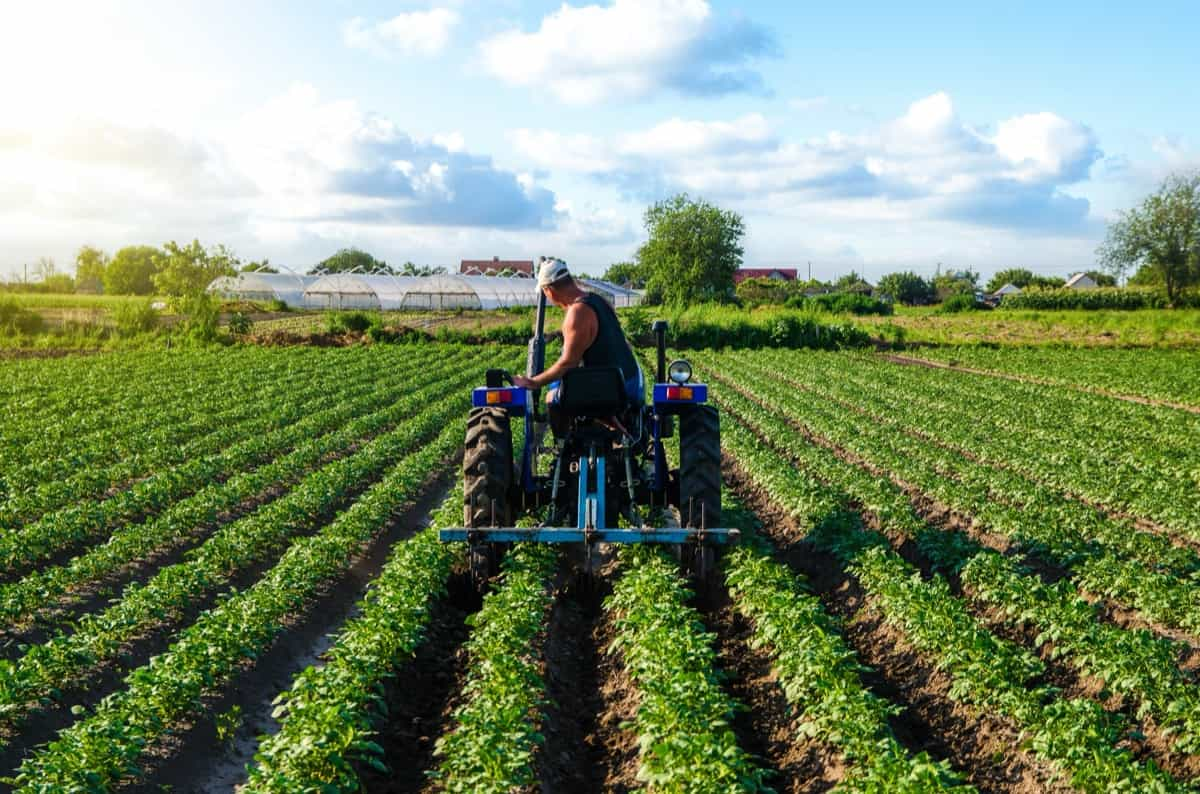
Commercial Potato Varieties
There are numerous varieties available, each with its unique characteristics and suitability for different growing conditions. Some popular commercial Potato varieties include Russet Burbank, known for its high yields and excellent storage capabilities. Yukon Gold is favored for its buttery flavor and golden skin, making it a favorite among chefs and consumers alike. Red Pontiac is another well-known variety recognized for its vibrant red skin and versatility in culinary applications.
Other popular varieties are Red Norland, Purple Majesty, Adirondack Blue, German Butterball, Bintje, Maris Piper, Charlotte, Desiree, etc. Kennebec potatoes are a reliable choice for those looking for early maturing options, with their smooth skin and white flesh. On the other hand, All Blue Potatoes stand out with their striking blue-purple skin and rich, nutty flavor profile.
Understanding Soil Requirements
Potatoes thrive in well-drained, loose, and fertile soil with a pH range of 5.0 and 6.5. This slightly acidic environment provides the ideal conditions for tuber development. Before planting Potatoes, it’s essential to conduct a soil test to assess their nutrient content and pH levels accurately. To ensure optimal growth, you can amend the growing soil by adding organic matter or fertilizers.
Potatoes require a good soil structure to allow tubers to develop without restrictions. Compacted soils can hinder root growth and lead to misshapen or undersized Potatoes. Regularly aerating the soil through tilling or other methods helps maintain proper drainage and air circulation.
Preparing the Land for Planting
It is a crucial step in successful Potato farming. The first step is to choose a well-drained field with fertile soil. Clear any debris, rocks, or weeds from the area to ensure optimal growing conditions. Next, plow and harrow the land to break up clods and create a fine seedbed. This helps with root penetration and water absorption. Consider conducting soil tests to determine nutrient levels and pH balance for proper fertilization later on.
In case you missed it: Weed Management in Potato: Common Weeds of Potato and Herbicides Safe for Use on Potatoes
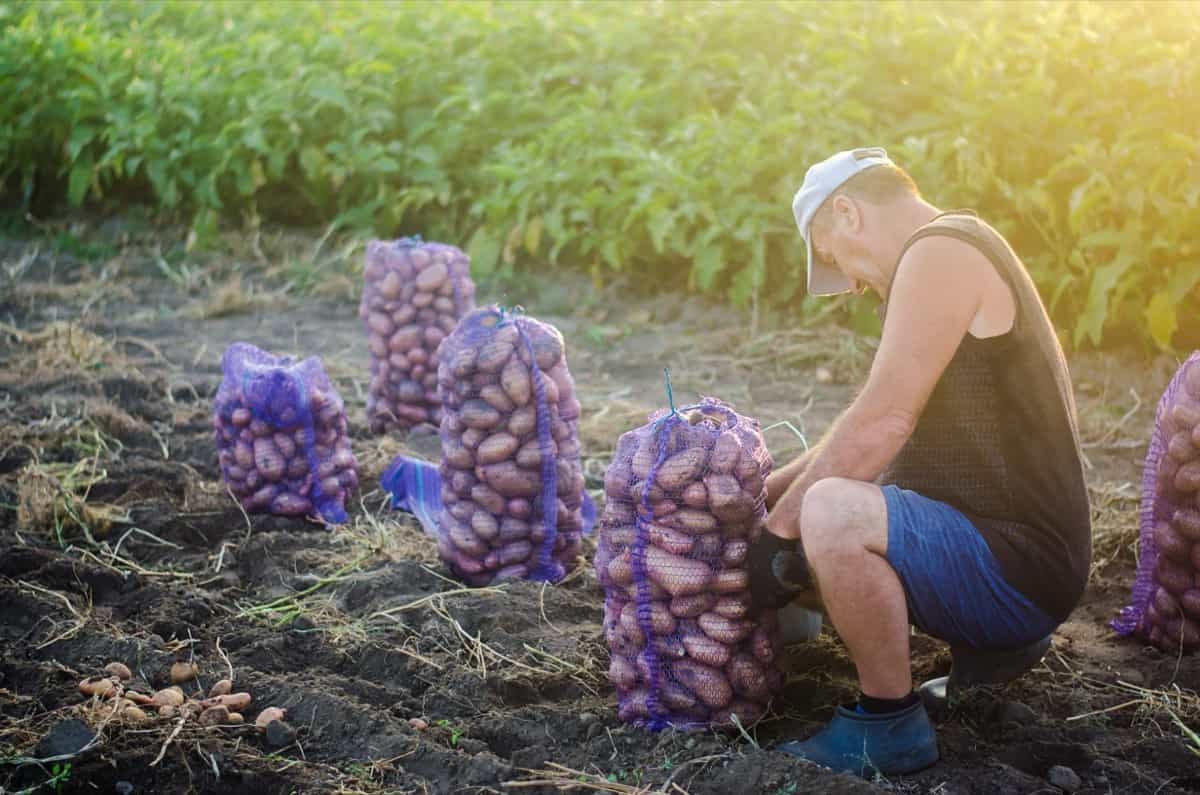
Once the soil is prepared, create ridges or furrows where you’ll plant your seed Potatoes. Ensure proper spacing between rows to allow for adequate growth space and airflow. Properly tilled soil will promote healthy tuber development throughout the season.
Planting Techniques and Timing
Potatoes are typically planted in early spring when the soil temperature reaches around 10°C. This is the optimal time for Potatoes to establish their roots and start growing. Before planting, make sure to prepare the soil by tilling it thoroughly and removing any debris or weeds. Potatoes thrive in loose, well-drained soil.
For planting, cut seed Potatoes into pieces with at least one eye each, allowing them to dry out before planting. Please place them in rows about 12 inches apart and cover them with soil. It’s essential to monitor weather conditions closely after planting to ensure proper growth. Adequate moisture is key during this stage, as dry conditions can hinder sprouting.
Watering and Irrigation Practices
Potatoes require consistent moisture levels to thrive, especially during the tuber formation stage. It is important to check soil moisture and adjust watering practices accordingly. Proper irrigation techniques can help prevent issues like cracking in Potatoes. Drip irrigation or soaker hoses are efficient methods that deliver water to the plant roots, reducing water wastage and promoting healthier growth.
Avoid overwatering the Potato plant as it can lead to diseases like late blight and rotting of tubers. On the other hand, underwatering can result in reduced yields and smaller tubers. Finding the right water balance is key to maximizing your Potato harvest. Consider some factors such as weather conditions, soil type, and plant growth stage when determining your watering schedule. By providing adequate hydration to your Potato plants, you can ensure a bountiful harvest at the end of the season.
Fertilization Strategies
Fertilization plays a crucial role in ensuring healthy crop growth and maximizing yields. Potatoes have specific nutrient requirements, with nitrogen, phosphorus, and potassium being essential elements for their development. Farmers need to carefully plan their fertilization strategies based on soil tests and the requirements of the Potato variety being grown. Applying organic matter like compost or manure can help improve soil structure, providing a gradual release of essential nutrients throughout the growing season.
In case you missed it: High-Yielding Potato Varieties in India: Hybrid Cultivars for Increased Profits
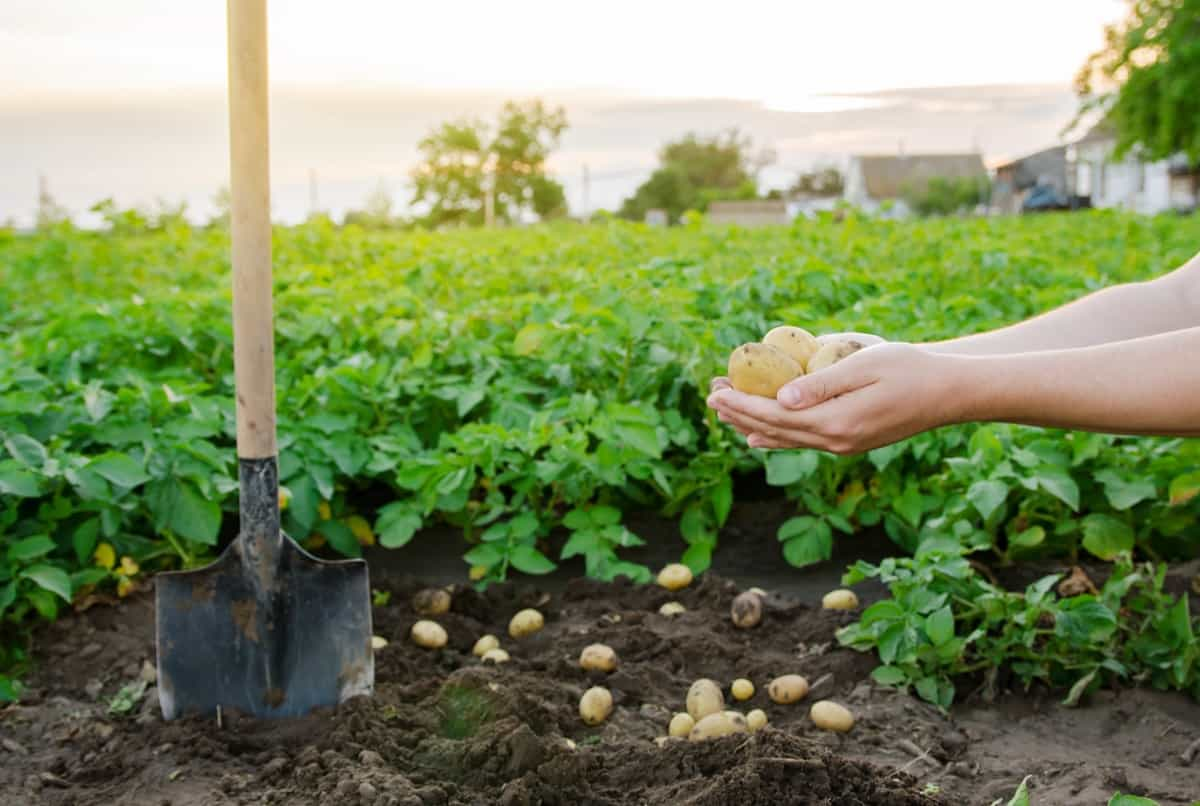
Additionally, using balanced chemical fertilizers at different stages of plant growth can supplement any nutrient deficiencies in the soil. Over-fertilizing can lead to nutrient imbalances and environmental pollution, so farmers need to follow recommended application rates and timings. Regular monitoring of plant health and adjusting fertilization practices accordingly is key to successful Potato cultivation.
Weed Management
Weeds compete with the Potato plants for nutrients, water, and sunlight, which can significantly reduce yield. To control weeds effectively, farmers can implement various strategies. One common method is manual weeding, where farmers physically remove weeds by hand or using tools like hoes. This technique is labor-intensive but can be effective in smaller fields. Another approach is mulching, which involves covering the soil around the Potato plants with organic materials like straw or grass clippings to suppress weed growth.
Mulching not only helps in weed control but also improves soil health. Using herbicides is another option for controlling weeds in larger-scale operations. However, it’s essential to select herbicides carefully to minimize negative impact on the environment and non-target plants. Implementing these methods based on the farm size and resources available can help farmers effectively manage weeds and ensure a successful Potato harvest.
Pest and Disease Control
These issues can significantly impact crop yield and quality if not managed effectively. The main strategy for pest control is to monitor the Potato plants for any signs of infestation regularly. By identifying problems early on, farmers can take prompt action to prevent further damage. Common pests include Potato beetles, aphids, and nematodes. These pesky insects can quickly multiply and wreak havoc on your crops if not properly managed.
Diseases like late blight and early blight are also common threats to Potato plants. Late blight is a fungal disease that thrives in humid conditions, causing dark lesions on leaves and tubers. Early blight, another fungal infection, leads to brown spots on lower leaves, which can spread rapidly if not treated promptly.
In case you missed it: Sweet Potato Fertilizer Requirements and Recommendations: Management Practices for Optimal Yield
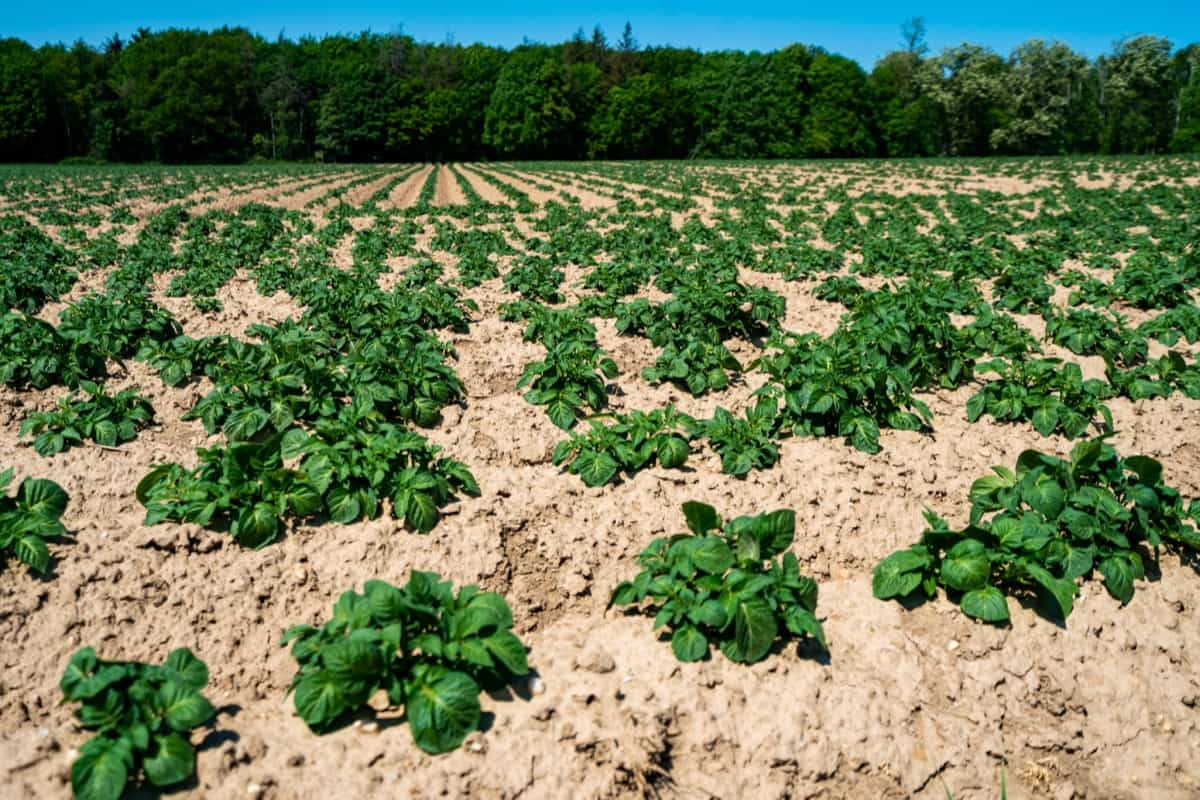
Implementing integrated pest management practices is essential in controlling pests while minimizing environmental impact. This approach involves using cultural, biological, and chemical methods to keep pest populations in check. For example, rotating crops can help disrupt the lifecycle of certain pests, while introducing beneficial insects can naturally control harmful ones.
When it comes to disease control, maintaining good hygiene practices, such as removing infected plant material and sanitizing tools between uses, can help prevent the spread of pathogens. Additionally, choosing disease-resistant Potato varieties can provide an added layer of protection against common infections.
Growth Monitoring and Care
Once your Potatoes are planted, it’s crucial to monitor their growth and provide the care they need to thrive. Regularly inspect your crops for any signs of nutrient deficiencies or pest infestations. Keep an eye on the development of the plants and adjust your watering and fertilization practices accordingly. Ensure that there is adequate spacing between the Potato plants to allow for proper air circulation.
This helps prevent diseases such as blight from spreading. As the plants grow, gently mound soil around them to protect developing tubers from exposure to sunlight. Regularly check soil moisture levels by inserting your finger into the ground near the roots. Water consistently but avoid over-saturation, as this can lead to rotting. Implement a schedule for weed control to reduce competition for nutrients and water.
Harvesting Techniques
When the plants have reached maturity, it’s time to harvest the tubers. Start by loosening the soil around the Potato plant with a fork or spade to avoid damaging the Potatoes. Carefully lift the Potatoes from beneath the soil, making sure not to bruise or cut them during harvest. Take your time to gather all the tubers from each plant while being mindful of their delicate nature.
Once harvested, allow the Potatoes to dry on top of the soil for a few hours before storing them. Proper harvesting techniques help preserve the quality and shelf life of your Potato crop. Remember, a successful harvest sets the stage for profitable Potato farming endeavors.
Average Yield
The average Potato yield per acre can change based on soil quality, weather conditions, and cultivation practices. On average, a well-maintained Potato farm can produce anywhere from 15 to 30 tons per acre. This figure may fluctuate based on your location and the specific variety of Potatoes you are growing. Proper irrigation, fertilization, weed management, and pest control play crucial roles in determining your final yield. Monitoring the growth of your Potato plants throughout their lifecycle is essential for maximizing productivity.
Post-Harvest Handling and Storage
After the Potatoes are harvested, it’s crucial to store them to extend their shelf life. Post-harvest handling involves sorting out damaged or diseased tubers, separating different sizes for market preference, and cleaning any dirt or debris. Storing Potatoes in a cool and well-ventilated environment is essential to prevent sprouting and rotting. Ideally, they should be stored in a root cellar or a basement that maintains a consistent temperature of around 7-10°C. Avoid storing them near fruits that release ethylene gas, as this can accelerate spoiling.
In case you missed it: Organic and Chemical Solutions to Get Rid of Potato Scab: Symptoms, Causes, and Treatment
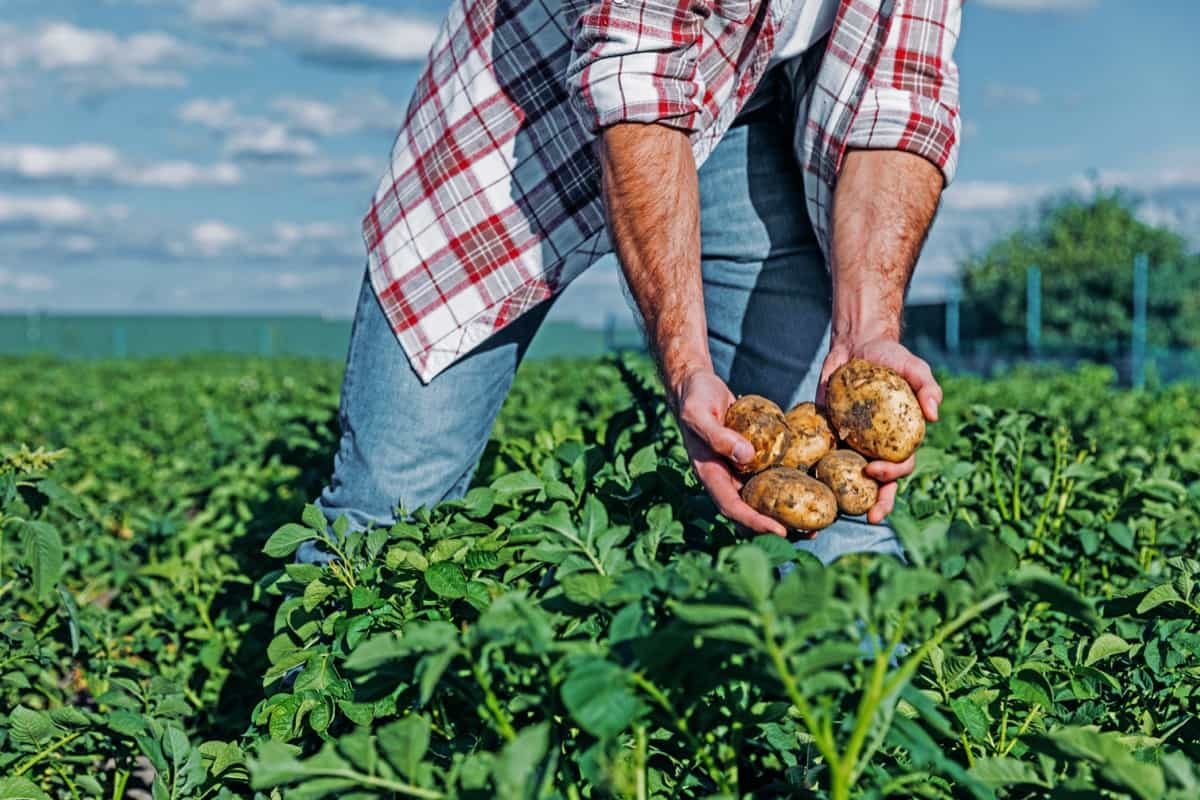
Proper storage containers like burlap sacks or perforated plastic bags help maintain the right humidity levels while allowing air circulation. Check stored Potatoes for any signs of decay or sprouting, and remove any affected ones promptly to prevent further spoilage.
Cost of Cultivation
Potato farming can be a lucrative venture, but it’s essential to have a clear understanding of the cost of cultivation per acre. The cost of Potato cultivation per acre can change based on factors such as location, agricultural practices, inputs used, labor costs, and market conditions. The cost of Potato cultivation per acre can range from Rs. 40,000 to Rs. 60,000 or more, depending on various factors.
Expected Profits
Potato farming can be a lucrative venture, with the potential for significant profits per acre. In India, the profit margins vary depending on factors like market prices, yields, and input costs. On average, farmers can expect to make anywhere from Rs. 50,000 to Rs. 1 lakh per acre through Potato cultivation. The key to maximizing profits lies in efficient management practices and strategic decision-making throughout the farming process.
By optimizing resources such as water usage, fertilizers, and pest control methods, farmers can increase their yield and, ultimately, their earnings. Farmers need to stay informed about market trends and demand fluctuations to capitalize on favorable selling opportunities. Additionally, investing in quality seeds and adopting modern farming techniques can lead to higher productivity levels and, consequently, higher profits at harvest time.
Sustainability Practices in Potato Farming
Sustainability is important for the long-term success of your Potato farm. Implementing sustainable ways not only benefits the environment but also improves the quality of your produce. The key practice is crop rotation, which helps to reduce the risk of Potato plant pests and diseases. Rotating Potato crops with other crops helps to reduce the risk of diseases and pests.
Implementing soil conservation techniques such as minimum tillage or conservation tillage helps reduce soil erosion, improve soil structure, and retain moisture. Mulching with organic materials also helps conserve soil moisture and suppress weeds. IPM strategies involve the use of biological controls, resistant plant varieties, crop rotation, and the use of pesticides to manage Potato plant pests and diseases while minimizing environmental impact.
In case you missed it: Cost of Cultivation of Potato Per Acre in India: Exploring from Seed Costs to Market Charges
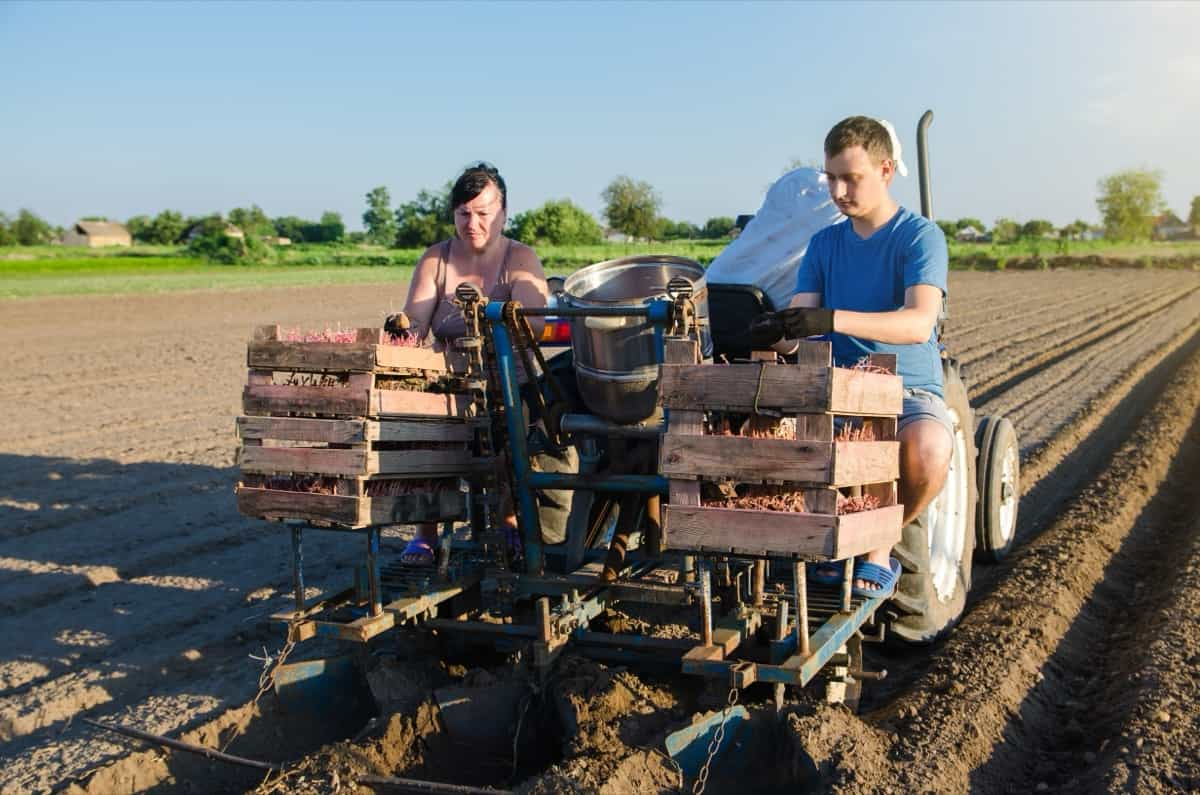
Using organic fertilizers and avoiding chemical pesticides can help preserve the natural balance of ecosystems on your farm. Water management systems such as drip irrigation can conserve water resources while ensuring optimal growth conditions for your Potatoes. Also, applying renewable energy sources like solar power can lower operating costs on your farm.
Overall, by implementing these farming practices, Potato farmers can contribute to the long-term viability of Potato farming systems. Potato farming plays a crucial role in the agricultural industry, serving as a staple food for many around the world.
- Economical Aquaculture: A Guide to Low-Budget Fish Farming
- 15 Common Planting Errors That Can Doom Your Fruit Trees
- How to Make Houseplants Bushy: Effective Tips and Ideas
- Innovative Strategies for Boosting Coconut Pollination and Yield
- Pollination Strategies for Maximum Pumpkin Yield
- The Complete Guide to Chicken Fattening: Strategies for Maximum Growth
- Natural Solutions for Tulip Problems: 100% Effective Remedies for Leaf and Bulb-Related Issues
- Revolutionizing Citrus Preservation: Towards a Healthier, Greener Future
- Natural Solutions for Peony Leaf and Flower Problems: 100% Effective Remedies
- Maximizing Profits with Avocado Contract Farming in India: A Comprehensive Guide
- Natural Solutions for Hydrangea Problems: 100% Effective Remedies for Leaf and Flowers
- The Ultimate Guide to Choosing the Perfect Foliage Friend: Bringing Life Indoors
- From Sunlight to Sustainability: 15 Ways to Use Solar Technology in Agriculture
- The Ultimate Guide to Dong Tao Chicken: Exploring from History to Raising
- The Eco-Friendly Makeover: How to Convert Your Unused Swimming Pool into a Fish Pond
- Mastering the Art of Delaware Chicken Farming: Essentials for Healthy Backyard Flocks
- 20 Best Homemade Fertilizers for Money Plant: DIY Recipes and Application Methods
- How to Craft a Comprehensive Free-Range Chicken Farming Business Plan
- Brighten Your Flock: Raising Easter Egger Chickens for Beauty and Bounty
- How to Optimize Your Poultry Egg Farm Business Plan with These Strategies
- Subsidy for Spirulina Cultivation: How Indian Government Schemes Encouraging Spirulina Farmers
- Ultimate Guide to Raising Dominique Chickens: Breeding, Feeding, Egg-Production, and Care
- Mastering the Art of Raising Jersey Giant Chickens: Care, Feeding, and More
- Ultimate Guide to Raising Legbar Chickens: Breeding, Farming Practices, Diet, Egg-Production
- How to Raise Welsummer Chickens: A Comprehensive Guide for Beginners
- How to Protect Indoor Plants in Winter: A Comprehensive Guide
- Ultimate Guide to Grow Bag Gardening: Tips, Tricks, and Planting Ideas for Urban Gardeners
- Guide to Lotus Cultivation: How to Propagate, Plant, Grow, Care, Cost, and Profit
- Agriculture Drone Subsidy Scheme: Government Kisan Subsidy, License, and How to Apply Online
- Ultimate Guide to Raising Araucana Chickens: Breed Profile, Farming Economics, Diet, and Care
- Bringing Hydroponics to Classroom: Importance, Benefits of Learning for School Students
- Ultimate Guide to Raising Polish Chickens: Breed Profile, Farming Economics, Diet, and Care
- Ultimate Guide to Raising Australorp Chickens: Profile, Farming Economics, Egg Production, Diet, and Care
- Silkie Chicken Farming: Raising Practices, Varieties, Egg Production, Diet, and Care
- Sussex Chicken Farming: Raising Practices, Varieties, Egg Production, Diet and Care
- Homemade Feed Formulations for Livestock: Discover Cost-effective Starter to Finisher Feed Recipes
Hi.
Can you please send me a brochure of about potato farming.
We don’t have PDF for farming yet, we will do soon. However, you can read online here at Agri Farming.
if you provide pdf it will be good
At this point in time we are not as people are making duplicates.
Can you share details on saving potato for seed purpose
Dear Reddy
Thanks for the information about Potato Farming and would you mind
let me know what it is mean by ‘qt/ha’ and also you haven’t mentioned
how many quantities of potato’s you need to plant in a ha and more details in planting materials.
Many Thanx
Anthony Silva
Colombo
qt/ha is nothing but quintal/hectare
Potatoes Are Good Starch ,Protein & Carbohydrates……On Our Ships see Have Potatoes & Tomatoes All aThe Time.
Do you also provide hands on training for potato cultivation and harvesting !
If So please share complete detail.
I love potatoes farming
Helps many farmers in the world
very informative, thank you.
Hi, Can you help to find LR/Santana POTATO Market in india. if any information about cold storage of APMC dealers.
Kindly advice how i can accelerate sprouting of potatoes ready for harvesting.
Hi,
Can you guide me about salinity level that potato plant can tolerate in arid soils